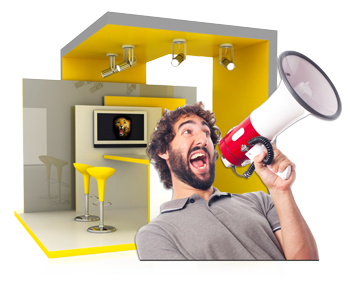Meet the Experts – Trade Show Booth & Marketing with Wolf Junius
Hello Wolf, welcome to The Exhibitor! Tell us a little about you and your professional journey.
After having successfully finished my MBA in marketing and management I didn’t spend a second thinking about joining the exhibition industry. This came very slowly and step by step during my career as a marketing consultant for German SME companies in the middle of the 1970’s.
What are the top 3 elements of a good trade show strategy?
- Determine your goals and specific objectives for your trade shows
- Treat your trade show cost figures as an investment in the future of your company
- Select your trade shows based on a careful evaluation including audited data
What are the most important aspects of a good marketing strategy at trade shows?
A successful trade show marketing strategy MUST contain the following three elements:
- Comprehensive pre-show marketing campaigns including a professional booth staff training. Exhibitors would better spend less on the exhibit construction and move those funds to enhance staff education. Use the power of business social media like LinkedIn and Twitter extensively.
- A professional at-show marketing focusing on generating VALUABLE leads. The leads must be directly qualified during the conversation. .
Only a well pre-organized Post-show campaign with consistent and consequent implementation will turn your leads into prospects and valuable clients. - In many cases, it makes much sense to invest some money in outsourcing some of the above-mentioned activities to specialized professionals.
Can exhibitors achieve their goals with a common 3x3m booth?
Case studies proved that the booth size is not so important if all above marketing campaigns have been run seriously. But, of course, a small booth will limit the number of attendee talks you can process in a perfect manner.
In such case, the exhibitor must limit the time spent with each visitor. The first step would be to install standing tables without stools only. The second step would be to use seriously a customizable lead retrieval app on the booth staff’s smart phones and tablets – like myfairtool, iCapture or BlueStone Nexus.
Your main focus is to provide “ROSI” – can you tell us more about it?
ROSI is our abbreviation for Return On Show Investment.
We are fully aware that only a small minority of all exhibitors is even able to calculate their ROSI in a reliable way for each attended show based on a comprehensive meaningful marketing automation system and a thoroughly run company controlling.
Therefore we have developed for our customers and prospects a simple to use Excel based ROSI calculation tool which contains our own more than 40 years of industry experience.
Many marketers are afraid of even starting to analyze their ROSI. Too much work, insufficient data, blah blah blah …just poor excuses. Really, it’s no rocket science and will not require weeks of your valuable workforce.
Just keep in mind that from floor space rental fee, over designing and building your booth up to travel and accommodation and much more, the total costs involved in exhibiting at a trade show can quickly sum up. Even a smaller trade show can cost your company a five-figure sum, especially if the venue is abroad.
Because trade shows require such a significant investment, it’s essential to measure and document not just how much you have spent at that trade show but also how much you have earned as a result of this participation.
Several surveys in Europe and US came to the same result: more than 50% of the exhibitors don’t measure their trade show ROI at all or insufficiently. What a waste of money and lost uncovered knowledge!
Measuring your events’ ROI is slightly more complicated than tracking and measuring online marketing ROI. However, with the right strategy and tools, you can get a clear picture of how much profit or value your next event will generate.
What is your method to calculate ROI / ROSI?
Start like a profiler
Divide your customers into broad categories. For example, completely new customers, returning regulars and those clients who have researched and analyzed the market a long time before making a final decision for you. At most 5 or 6 categories.
Then you should investigate the following questions:
- Why did these clients order your products or services?
- What influenced their purchase decision?
- Where did they get in contact with you or first heard about you? And so on.
ROSI means Looking at the Facts
It’s important to discover relevant facts about your sales & marketing. How many companies that appear on your lead list, have actually already turned into customers? How many clients had visited your exhibit at a trade show? How many leads did you collect there? How many of these leads were followed-up?
These hard facts help separate wishful thinking from reality. Make sure that, at the very least, you understand some of the things that are working fine for you. There will still be a lot of holes in your knowledge, but at least you’ll know what you know and what is still to be learned.
ROSI analysis can discover lost opportunities
It’s not always easy to define the effectiveness of your trade show campaigns. Your existing clients can tell you which tactic worked for them — but look for the piece that is consistently missing. Where are you not detecting and identifying potential prospects or customers? Why aren’t they finding you? If you’re winning client A, C, and E, why not B, D, and F?
Build your future strategy always on what has been proven to work but also analyze which activities have not been effective to reach out to new prospects or customers.
What should a good follow-up email contain to be effective?
A good first follow-up email should arrive as early as possible, at best during the evening of the meeting day.
It must be personalized and mention all the topics of the conversation at the booth, not only a simple “Thank you for your visit…”.
It should describe shortly the specific benefits of your product or service for the visitor aka. prospect.
At the end, there must be a CTA (Call To Action). The reader must understand instantly which step to take next.
myfairtool provides solutions to build a company page to promote your booth and a solution to capture leads digitally to speed up the follow-up process and reduce the workload – what is your professional opinion?
I am very much in favor of “easy-to-use” lead capture applications which can be installed on any smartphone or tablet and also work without permanent WIFI connectivity.
My basic suggestion is KISS: Keep it Stupid and Simple. The more sophisticated and comprehensive the app, the less it will be used, especially by SME exhibitors. And they are the absolute majority on all fair grounds, all over the world.
Using a company page to promote your booth at a specific show can be useful if it’s fully SEO optimized for the common locally used attendee search terms.
In my personal opinion, that strategy isn’t anymore state-of-the-art. For many major and international exhibitions, exhibitors should reach out to attendees by using Business social Media, like LinkedIn, Twitter and maybe Facebook. There, they should join the related groups at an early stage and use the specific hashtags. But only for providing valuable content to the attendees in a continuous manner and not by sending out pure self-promotional message blasts.
Remember, you have to send out at least 8 to 9 different messages on all available media before you get the chance that the attendee becomes even aware of your company, product and/or service.




Pingback: Meet the Experts - Trade Show Booth & Marke...()